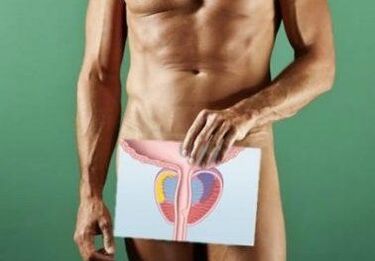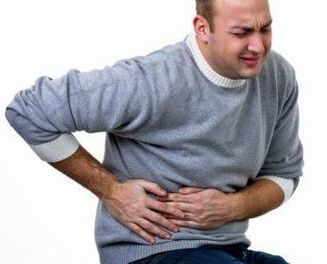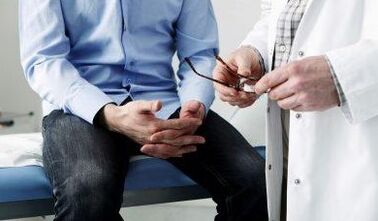Inflammation of the prostate is a serious disease that can lead to serious consequences if left untreated.The prostate is located below the bladder.
When inflamed, its size increases significantly, blocking the neck of the bladder and interfering with urine flow.Therefore, with the initial symptoms and manifestations, it is necessary to contact the expert immediately to identify and start treatment of prostatitis.

Main symptoms: How do prostatitis manifest?
It was previously thought that this was a disease for adults and older men, but under modern living conditions (ecology, quality of food, fashion, youth's negligent attitude towards health, constant car movement, etc.), inflammation of the prostate is "young".
The incidence rate for young people under 18 is 5%, aged between 18 and 30 years - 45%, from 30 to 50 years - 20%, and over 50 years - 30%.This shows the need to follow your male health and listen to the symptoms of youth.
There are several types of prostatitis in manifestations (chronic, acute) and inflammatory types (bacterial, stagnant, suppurative, infectious, calcified).The symptoms of the disease may vary depending on the type of prostatitis in men.
Symptoms of acute prostatitis:
- Bad wells (weakness, chills, fever).A person can start throwing in hot or cold.The general symptoms are similar to those of SARS or flu;
- Body temperature rises sharply to subsurface marks (37.5-38 degrees), and is higher;
- Severe cutting, pain in sutures in the groin area (grimum, anus, etc.);
- Lower back pain, hips, legs, knees, feet or muscles;
- acute pain during bowel movement and filtration;
- Urination problems (insufficient / urine, urination, pain or difficulty urinating).Long delay in urine (more than 12 hours);
- deterioration of sexual function (weak or no erection at all, ejaculation, conception problems);
- Exit from the genitals (in the most severe and advanced cases of prostatitis).
Symptoms of chronic prostatitis:
- Urination problems (difficulty in urination, pain, insufficient urine, feeling of incomplete emptying of the bladder, etc.);
- Pain and feeling unpleasant on pants, between legs, groin, anus.Pain syndrome was not obvious;
- In the groin, sometimes severe pain or strong burning will appear, which will turn into the feet.
- Long-term general discomfort (sleepiness, indifference, depression, persistent fatigue, muscle weakness, etc.);
- Nervous, irritable;
- Body temperature increased slightly.Sometimes, sub-release temperatures may remain for a long time;
- Reduced sexual function (erection problems, reduced or lack of ejaculation, decreased sexual desire, infertility, etc.).

The chronic course of prostatitis involves periods such as remission and recurrence.During recurrence, symptoms of chronic form may develop into symptoms of acute form of the disease.
Bacterial symptoms:
- signs of the inflammatory process (heat, fever, fever, general weakness, pain syndrome in muscles and bones);
- Signs of local inflammation of the prostate (perineal pain, groin, anus);
- There is a problem with urination;
- Change the consistency, color and smell of fluids (urinary, secrets of prostate, sperm, blood).
Calculate symptoms:
- Lower back, s-bone, crot, weak anus and moderate pain syndrome;
- Surgery, groin burn;
- Pain is significantly enhanced after intercourse and during active exercise;
- Urination problems, bladder burst sensation;
- Less desire, problems with ejaculation and erection (until erectile dysfunction);
- In late stages, blood drops may occur in sperm (it turns light pink or bright red).
Symptoms of stagnant forms:
- Constant unpleasant sensations in the groin, crot and anal areas;
- Periodic tension pain;
- There is a problem with urination, and one feeling is not the complete immobility of the bladder.
- The temperature is constantly elevated to the sub-release mark;
- The manifestations of general inflammatory processes in the body (ESR, discomfort, lethargy, fatigue, headache, weakness, muscle pain, etc.);
- Problems in the reproductive area (ejaculation and erection, infertility);
- Neurological condition, depression, indifference.
Symptoms of infection form:
- Signs of inflammation in the body (the value of ESR in men's blood increases, muscle pain, fever);
- Lower back, groin and perineal pain;
- Pain during bowel movements;
- Severe pain in the groin and perineum;
- Urination problems (difficulty, urination, lack of impulse, etc.).
Symptoms of purulent:
- Body temperature rises sharply (above 38, 5 degrees);
- Signs of inflammatory processes in the body (high value of ESR, muscle pain, heat, chills, etc.);
- obvious pain syndrome in the groin, perineum and anus;
- Severe pain in the perineum;
- Difficulty in urination, painful urination;
- Purulent discharge from genitals.
What is the first sign of a man?
As prostatitis begins, only some symptoms of the disease occur.For signs of inflammation in the prostate, special attention should be paid to the following situations:

- Unpleasant sensations in the perineum;
- Periodic weak tension pain in the groin and perineum;
- During the bowel movement (without hemorrhoids), unpleasant sensations are pulled in the anus and intestines;
- Long-term discomfort has nothing to do with SARS, tonsillitis, influenza and other colds;
- Reduced sexual desire, malfunction during ejaculation and erection (their periodic absence);
- Decreased quality of orgasm;
- Unpleasant sensations in the urethra and groin during or after intercourse;
- sperm consistency, color and odor changes;
- Improve body temperature.
Signs of expressing acute prostatitis:
- For no obvious reason, the temperature rose to 37.5-40 degrees (not cold, not flu, not angina);
- The frequency of urination increased by 3-4 times, accompanied by severe pain.Urine flows slowly and has weaker pressure;
- Burn in the groin, perineum and during bowel movements.intestinal pain during bowel movements;
- Pus (severe course and purulent form of the disease) is discharged from the intestine or urethra.
Clear signs of chronic inflammation of the prostate:
- Burn in the groin and perineum.burning in the genitals (especially during urination and sex);
- Exhaust it in the urethra after urination and during filtration (active exercise or defecation).Exit from the rectum;
- Tension, depression, irritability;
- There is no obvious reason for rapid fatigue, lethargy.
Pain syndrome of prostatitis
Almost always, with inflammation of the prostate, a person can understand the cause of pain syndrome through its characteristics.Characteristic pull, pain or acute pain occurs in the crot and groin.Recurs in acute or chronic pain forms, which are characterized by acute, sharp, painful, cutting and pulling.In the chronic form of the disease, the pain is periodic, wavy.Moreover, pain syndrome may be weak but constant.The inflamed prostate is pressed on the urethra, bladder and its ureters.It is on these channels that urine comes out of the bladder and pain occurs during urination.Similarly, pain during urination may be a sign of infection in the bladder or urogenital system (sexually transmitted disease).
The accompanying pain can occur completely differently.Just as prostatitis with several pains may not be inflammation of the prostate at all, but inflammation of other diseases.
Other causes of pain:
- Abdominal pain is a symptom of many other diseases.An obvious example is appendicitis, acute poisoning, intestinal infection or interreligious.
- The lower back is damaged by hernia, osteochondrosis, clamping of nerve ends, osteoporosis, osteosclerosis and other spinal diseases.
- Anal pain can be caused by hemorrhoids, cracks, bruises, prolonged sitting on uncomfortable solid surfaces and various tumors (beautified or malignant).
- Pain syndrome in the bone and spine is more severe.These are usually problems with bones, vertebrae and discs (osteochondrosis, osteoporosis, displacement, pinching, etc.).

Sometimes, pain in the bone means problems with other internal organs (kidneys, intestines, bladder and ureters), gynecological diseases, thrombotic varicose veins, inflammation of the pelvic organs.
- Soreness in the legs can mean inflammation of flat feet, thrombotic varicose veins, atherosclerosis, varicose veins, arthritis, osteoporosis, sciatic nerves and even diabetes.Leg pain can have many different causes.
The most common is leg and muscle fatigue.
Which specialist is treating the disease?
Among the patients, only one qualified doctor was diagnosed with the patient, the urologist.He collects one to disband and examines the patient.He then instructed the man to perform tests (PSA-antigen proteins for prostatitis) and ultrasound examinations of the pelvic organs.
Similarly, patients who do not fail will pass general blood and urine tests.Based on the results of all analyses, urologists can accurately determine the diagnosis and form of prostatitis.Only after these procedures can the doctor prescribe a single treatment regimen, including medications, antibiotics and other medications that usually occupy the house.
In 95% of cases, a man knows exactly what urologists will do because the pain is very specific when the prostate becomes inflamed.It is necessary to listen to your body constantly to monitor all changes that occur in the body.This is the only way for men to maintain their men’s health over the years.Neglected prostatitis not only threatens urinary disorders, but also threatening diseases, ejaculation, erection problems that can ultimately lead to infertility.













